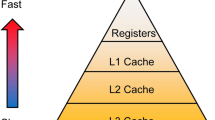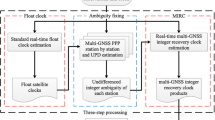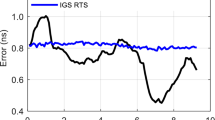Abstract
Precise satellite clock corrections are the key elements for the implementation of Real-Time Precise Point Positioning (RTPPP). To fully promote the capability of multi-GNSS RTPPP, an efficient method is proposed for the precise estimation of multi-GNSS high-rate satellite clock corrections in real time. Different from the epoch-differenced methods in the current literature, the proposed method is based on undifferenced observations and the function models are established to achieve high processing efficiency and full-parameter accessibility at the same time. In the proposed method, main data processing is performed based on two function models: the full-parameter (FP) model and the high-rate (HR) model. In the FP model, both code and phase observations are used, mainly for the estimation of the large number of phase ambiguities, which is actually the most time-consuming part in clock estimation. In the HR model, high-rate clock corrections are estimated with only phase observations, in which the latest ambiguity estimates and corresponding variance information obtained from the FP model are introduced as phase corrections to reduce the size of the normal equations and guarantee high processing efficiency for the HR processing. With the proposed method, real-time estimation of high-rate (1 Hz) clock corrections for a quad-system (GPS/GLONASS/Galileo/BeiDou) solution with real-time streams has been realized and validated. Satellite clock corrections are encoded to state-space representative corrections and broadcasted to the user side to support multi-GNSS RTPPP. Results show that the proposed method is highly efficient and can provide 1 Hz or even higher-rate clock corrections for multi-GNSS in real time. Quad-system real-time satellite clocks are compared with the post-processed products from GFZ. Positioning performances of RTPPP, including positioning accuracy and convergence speed, have also been validated and analyzed. All the results show that the proposed method is effective, efficient, accurate and promising in multi-GNSS real-time high-rate clock estimation.
















Similar content being viewed by others
References
Cai C, Gao Y (2013) Modeling and assessment of combined GPS/GLONASS precise point positioning. GPS Solut 17(2):223–236
Chen Y, Yuan Y, Ding W, Zhang B, Liu T (2017) GLONASS pseudorange inter-channel biases considerations when jointly estimating GPS and GLONASS clock offset. GPS Solut 21(4):1525–1533
Chen Y, Yuan Y, Zhang B, Liu T, Ding W, Ai Q (2018) A modified mix-differenced approach for estimating multi-GNSS real-time satellite clock offsets. GPS Solut 22(3):72
Choy S, Bisnath S, Rizos C (2017) Uncovering common misconceptions in GNSS Precise Point Positioning and its future prospect. GPS Solut 21(1):13–22
Chuang S, Wenting Y, Weiwei S, Yidong L, Rui Z (2013) GLONASS pseudorange inter-channel biases and their effects on combined GPS/GLONASS precise point positioning. GPS Solut 17(4):439–451
Colosimo G, Crespi M, Mazzoni A (2011) Real-time GPS seismology with a stand-alone receiver: a preliminary feasibility demonstration. J Geophys Res Solid Earth 116(B11):B11302
Dach R, Lutz S, Walser P, Fridez P (2015) Bernese GNSS Software Version 5.2. Astronomical Institute, University of Bern, Switzerland
De Jonge P (1998) A processing strategy for the application of the GPS in networks. Ph.D. thesis, Delft University of Technology
Elsobeiey M, Al-Harbi S (2016) Performance of real-time Precise Point Positioning using IGS real-time service. GPS Solut 20(3):565–571
Ge M, Gendt G, Rothacher M et al (2008) Resolution of GPS carrier-phase ambiguities in precise point positioning (PPP) with daily observations. J Geod 82(7):389–399
Ge M, Chen J, Douša J et al (2012) A computationally efficient approach for estimating high-rate satellite clock corrections in realtime. GPS Solut 16(1):9–17
Geng J, Meng X, Dodson AH et al (2010) Rapid re-convergences to ambiguity-fixed solutions in precise point positioning. J Geod 84(12):705–714
Gong X, Gu S, Lou Y et al (2018) An efficient solution of real-time data processing for multi-GNSS network. J Geod 92(7):797–809
Guo J, Xu X, Zhao Q et al (2016) Precise orbit determination for quad-constellation satellites at Wuhan University: strategy, results, validation, and comparison. J Geod 90(2):143–159
Hadas T, Bosy J (2015) IGS RTS precise orbits and clocks verification and quality degradation over time. GPS Solut 19(1):93–105
Hauschild A, Montenbruck O (2009) Kalman-filter-based GPS clock estimation for near real-time positioning. GPS Solut 13(3):173–182
Kazmierski K, Sośnica K, Hadas T (2018a) Quality assessment of multi-GNSS orbits and clocks for real-time precise point positioning. GPS Solut 22:11
Kazmierski K, Hadas T, Sośnica K (2018b) Weighting of multi-GNSS observations in real-time precise point positioning. Remote Sens 10(1):84
Kouba J (2009) A guide to using International GNSS service (IGS) products. http://igscb.jpl.nasa.gov/igscb/resource/pubs/UsingIGSProductsVer21.pdf. Accessed Sept 2016
Kouba J, Héroux P (2001) Precise point positioning using IGS orbit and clock products. GPS Solut 5(2):12–28
Laurichesse D, Mercier F, Berthias J et al (2009) Integer ambiguity resolution on undifferenced GPS phase measurements and its application to PPP and satellite precise orbit determination. Navigation 56(2):135–149
Li X, Ge M, Zhang X et al (2013) Real-time high-rate co-seismic displacement from ambiguity-fixed precise point positioning: application to earthquake early warning. Geophys Res Lett 40(2):295–300
Li X, Ge M, Dai X, Ren X, Fritsche M, Wickert J, Schuh H (2015a) Accuracy and reliability of multi-GNSS real-time precise positioning: GPS, GLONASS, BeiDou, and Galileo. J Geod 89(6):607–635
Li X, Zus F, Lu C et al (2015b) Retrieving of atmospheric parameters from multi-GNSS in real time: validation with water vapor radiometer and numerical weather model. J Geophys Res Atmos 120(14):7189–7204
Liu T (2017) Study on the algorithms and ionospheric applications of Multi-GNSS uncombined precise point positioning. Ph.D. thesis, Institute of Geodesy and Geophysics, Chinese Academy of Sciences, Wuhan, China (in Chinese)
Liu T, Yuan Y, Zhang B et al (2017) Multi-GNSS Precise Point Positioning (MGPPP) using raw observations. J Geod 91(3):253–268
Liu T, Zhang B, Yuan Y, Li M (2018) Real-Time Precise Point Positioning (RTPPP) with raw observations and its application in real-time regional ionospheric VTEC modeling. J Geod 92(11):1267–1283
Loyer S, Perosanz F, Mercier F et al (2012) Zero-difference GPS ambiguity resolution at CNES-CLS IGS analysis center. J Geod 86(11):991–1003
Odijk D, Zhang B, Khodabandeh A et al (2016) On the estimability of parameters in undifferenced, uncombined GNSS network and PPP-RTK user models by means of S-system theory. J Geod 90(1):15–44
Odijk D, Khodabandeh A, Nadarajah N et al (2017) PPP-RTK by means of S-system theory: Australian network and user demonstration. J Spat Sci 62(1):3–27
Orgiazzi D, Tavella P, Lahaye F (2006) Experimental assessment of the time transfer capability of precise point positioning (PPP). In: Frequency control symposium and exposition, proceedings of the 2005 IEEE international, pp 337–345
Samper L, Merino M (2013) Advantages and drawbacks of the Precise Point Positioning (PPP) technique for earthquake, tsunami prediction and monitoring. Proc Ion Pacific Pnt Meet 8900(6):9–26
Sleewagen JM, Simsky A, de Wilde W et al (2012) Demystifying GLONASS inter-frequency carrier phase biases. Inside GNSS 7(3):57–61
Teunissen P, Khodabandeh A (2015) Review and principles of PPP-RTK methods. J Geod 89(3):217–240
Weber G, Mervart L, Lukes Z, Rocken C, Dousa J (2007) Real-time clock and orbit corrections for improved point positioning via NTRIP. In: Proceedings of ION-GNSS-2007, Institute of Navigation, 25–28 Sept, Fort Worth, TX, USA, pp 1992–1998
Wu J, Wu S, Hajj G et al (1993) Effects of antenna orientation on GPS carrier phase. Manuscripta Geodaetica 18(2):91
Zhang X, Li X, Guo F (2011) Satellite clock estimation at 1 Hz for real-time kinematic PPP applications. GPS Solut 15(4):315–324
Zhang B, Ou J, Yuan Y (2014) Method of processing GNSS reference network data with refined datum definition for rank-deficiency elimination. Acta Geodaetica et Cartographica Sinica (in Chinese) 43(9):895–901
Zhang W, Lou Y, Gu S et al (2016) Joint estimation of GPS/BDS real-time clocks and initial results. GPS Solut 20(4):665–676
Zhang B, Liu T, Yuan Y (2018) GPS receiver phase biases estimable in PPP-RTK networks: dynamic characterization and impact analysis. J Geod 92(6):659–674
Zumberge J, Heflin M, Jefferson D, Watkins M, Webb F (1997) Precise point positioning for the efficient and robust analysis of GPS data from large networks. J Geophys Res 102(B3):5005–5017
Acknowledgements
The authors would like to acknowledge the MGEX, GA, CNES, GFZ and CODE for providing access to the real-time multi-GNSS data streams, real-time SSR satellite orbit corrections for multi-GNSS (CLK93), post-processed satellite orbit, clock and intra-frequency DCB products. Many kind helps from Dr. Denis Laurichesse are highly appreciated. Funding supports from China Natural Science Funds (Nos. 41804037 and 41674022) and National key Research Program of China “Collaborative Precision Positioning Project” (No. 2016YFB0501900) are also gratefully acknowledged. The second author is supported by the CAS Pioneer Hundred Talents Program. The third author acknowledges LU JIAXI International team program supported by the K.C. Wong Education Foundation and CAS.
Author information
Authors and Affiliations
Corresponding authors
Rights and permissions
About this article
Cite this article
Liu, T., Zhang, B., Yuan, Y. et al. An efficient undifferenced method for estimating multi-GNSS high-rate clock corrections with data streams in real time. J Geod 93, 1435–1456 (2019). https://doi.org/10.1007/s00190-019-01255-9
Received:
Accepted:
Published:
Issue Date:
DOI: https://doi.org/10.1007/s00190-019-01255-9




